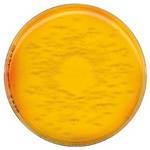Staphylococcus aureus
- Organism Specific Information
- Concatenate Sequences
- Download Alleles
- Download ST’s
- Compare profile to refset
- Draw tree using own MLST data
- download as MS Excel
- download as MS Access
- S.aureus Links
- eBURST V3
- Contact Curator
Staphylococcus aureus is a widespread gram-positive motionless facultative anaerobic non-spore-forming bacterium related to cocci, spherical bacteria. This microorganism is part of the normal microflora of the skin and mucous membranes in 15-50% of healthy people and animals.
Staphylococcus aureus is found in soil and water, often contaminates food products. It is able to infect all tissues and organs: skin, subcutaneous tissue, lungs, central nervous system, bones, and joints, etc. This bacterium can cause sepsis, purulent skin lesions, and wound infections.
The optimum temperature for Staphylococcus aureus is 30-37 °C. It withstands for 20-30 minutes when 70-80 °C + dry heat. It survives for up to 2 hours. This bacterium is resistant to drying and salinization. It is able to grow on media with 5-10% sodium chloride content, including fish, meat and other products. Most disinfectants destroy Staphylococcus aureus.
Staphylococcus aureus releases a wide variety of toxins. Membranotoxins (hemolysins) of four types provide hemolysis, in addition, membranotoxin. In experiments, it causes skin necrosis, and when administered intravenously – the death of animals. Exfoliatins of two types bring damage to skin cells. Leukocidin causes a violation of the water-electrolyte balance in the cells of leukocytes, especially macrophages, neutrophils, and monocytes, which results in their death.
Staphylococcus aureus can enter products from the environment, with water or soil. The carriers of this bacterium are both sick and healthy people and animals. Most often, food toxicoinfections caused by Staphylococcus occur when you take confectioneries with cream, ready-to-cook food and other products that do not require additional heat treatment.
Intoxication with staphylococcal infection
The disease cause is the toxins produced by Staphylococcus aureus, so the disease is characterized by a very short incubation period – usually from 0.5 to 6 hours. The patient’s susceptibility to toxins is determined by the patient’s condition, the concentration of the toxin and the amount of contaminated product eaten. The infectious dose may be less than 1.0 μg, which corresponds to approximately 100,000 CFU/G of product. The most common symptoms of the disease are nausea, vomiting, aversion to food, abdominal cramps, and diarrhea. The rehabilitation period takes, as a rule, 1-3 days. In severe cases, a full recovery may take longer. The disease is not transmitted to others, patients need to take a large amount of fluid.
Detection method
The detection method of S. aureus is based on seeding a sample weight of a product and/or diluting its sample in a selective liquid medium, incubating the crops, transferring the culture liquid to the surface of an agarized selective diagnostic medium, confirming by biochemical characteristics that the selected typical and/or atypical colonies belong to S. aureus.


